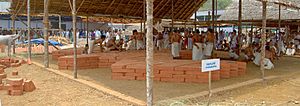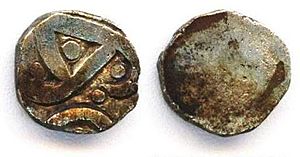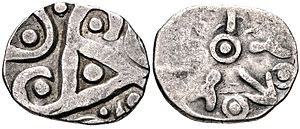Kuru Kingdom facts for kids
Quick facts for kids
Kuru Kingdom
|
|||||||||||||
|---|---|---|---|---|---|---|---|---|---|---|---|---|---|
| c. 1200 BCE – c. 500 BCE | |||||||||||||
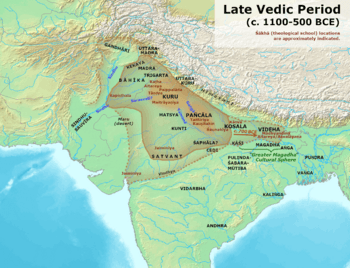
Kuru and other kingdoms in the Late Vedic period.
|
|||||||||||||
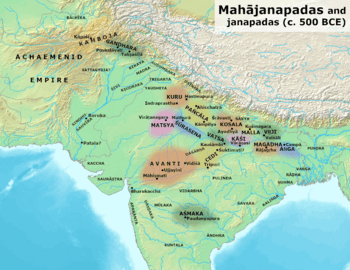
Kuru and other Mahajanapadas in the Post Vedic period.
|
|||||||||||||
| Capital | Āsandīvat, later Hastinapura and Indraprastha | ||||||||||||
| Common languages | Vedic Sanskrit | ||||||||||||
| Religion | Historical Vedic religion |
||||||||||||
| Government | Monarchy | ||||||||||||
| Raja (King or Chief) | |||||||||||||
|
• 12th–9th centuries BCE
|
Parikshit | ||||||||||||
|
• 12th–9th centuries BCE
|
Janamejaya | ||||||||||||
| Historical era | Iron Age | ||||||||||||
|
• Established
|
c. 1200 BCE | ||||||||||||
|
• Disestablished
|
c. 500 BCE | ||||||||||||
|
|||||||||||||
| Today part of | India | ||||||||||||
The Kuru Kingdom (Sanskrit: कुरु) was an important ancient kingdom in northern India. It was formed by a group of Indo-Aryan tribes during the Iron Age (around 1200 to 500 BCE). This kingdom covered parts of what is now Delhi, Haryana, Punjab, and western Uttar Pradesh.
The Kuru Kingdom was special because it was the first recorded "state-level society" in the Indian subcontinent. This means it had a more organized government and society than earlier tribes. The Kurus played a big role in shaping the religious traditions of ancient India. They organized their sacred hymns into collections called the Vedas. They also developed new religious ceremonies known as Srauta rituals. These changes helped create the early forms of what we now call Hinduism.
During the Middle Vedic period (about 1200 to 900 BCE), the Kuru Kingdom was a powerful cultural and political center. Famous kings like Parikshit and Janamejaya ruled during this time. However, the kingdom became less important in the late Vedic period (about 900 to 500 BCE). Even so, stories and legends about the Kurus lived on. These stories later became the basis for the famous epic poem, the Mahabharata.
Most of what we know about the Kuru Kingdom comes from the Vedas. These ancient texts describe life during that time and mention historical people and events. Archeologists have also found evidence, like Painted Grey Ware pottery, that matches the time and place of the Kuru Kingdom.
Contents
History of the Kuru Kingdom
The Kuru clan came together in the Middle Vedic period (around 1200 to 900 BCE). This happened after different tribes, like the Bharata and Puru clans, formed an alliance. They had fought in a big conflict called the Battle of the Ten Kings.
The Kurus set up their main power center in the Kurukshetra region. This area became the first important political hub of the Vedic period. The Kurus were powerful from about 1200 to 800 BCE. Their first capital city was Āsandīvat, which is now Assandh in Haryana. Later, other writings mention Indraprastha (modern Delhi) and Hastinapura as major Kuru cities.
The Kuru people are often mentioned in Vedic texts written after the Rigveda. These texts show the Kurus as a branch of the early Indo-Aryans. They ruled the area between the Ganga and Yamuna rivers, known as the Doab, and also modern Haryana. Over time, the main center of Vedic culture moved from Punjab to Haryana and the Doab, making the Kuru clan very important.
Archeological findings support this shift. There are more and larger Painted Grey Ware (PGW) settlements in Haryana and the Doab. Surveys in the Kurukshetra District show that between 1000 and 600 BCE, society became more complex. There were different levels of settlements, suggesting an early state or a complex chiefdom. While most PGW sites were small farming villages, some grew into towns. The largest towns had simple defenses like ditches and wooden fences.
The Atharva Veda praises Parikshit, the "King of the Kurus." It describes his kingdom as rich and successful. Other later Vedic texts, like the Shatapatha Brahmana, celebrate Parikshit's son, Janamejaya. He was known as a great conqueror who performed the ashvamedha (horse-sacrifice). These two Kuru kings were very important in building the Kuru state and developing the srauta rituals. They also appear as key figures in later legends, like the Mahabharata.
The Kuru Kingdom eventually declined after being defeated by the Salva tribe. The center of Vedic culture then moved east to the Panchala kingdom in Uttar Pradesh. Later stories say the Kuru capital moved to Kaushambi after Hastinapur was damaged by floods and family problems. By the 6th century BCE, the Kuru dynasty had split into two smaller kingdoms: Kuru and Vatsa.
Kuru Society
The tribes that formed the Kuru Kingdom were mostly semi-nomadic. This means they moved around with their animals, practicing pastoralism. But as they settled in the western Ganges Plain, farming became more important. They grew crops like rice and barley.
Writings from this time show that people started producing more food than they needed. This led to the rise of specialized workers and craftsmen. Iron was first mentioned in the Atharva Veda as śyāma āyas (meaning "black metal").
Another big change was the development of the four-part varna (class) system. This replaced an older two-part system.
- The Brahmin priests and Kshatriya warriors became the top classes.
- The common people, called arya, were now known as vaishyas.
- The laborers, called dasa, were now known as shudras.
These four classes became separate groups in society.
Kuru kings ruled with the help of a basic government. This included a purohita (priest), a village leader, an army chief, and other officials. Kings collected mandatory payments, called bali, from their people and from weaker neighboring tribes. They often led raids and conquests against nearby groups, especially to the east and south.
To help govern, the kings and their Brahmin priests organized Vedic hymns into collections. They also created new rituals, called Srauta rituals. These rituals helped maintain social order and strengthen the class system. Important nobles could perform very complex sacrifices. Many rituals mainly honored the king and showed his power over his people. The ashvamedha, or horse sacrifice, was a way for a powerful king to show his control over northern India.
Kuru Kingdom in Epic Stories
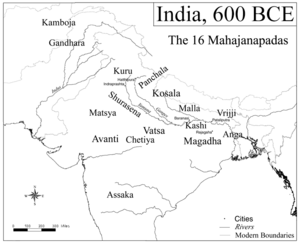
The famous epic poem, the Mahabharata, tells a story about a conflict between two branches of the Kuru family. This conflict might have happened around 1000 BCE. However, archeologists have not found clear proof that the exact events described in the epic really happened. The Mahabharata text itself was written and changed over many centuries, mostly between 400 BCE and 400 CE.
In the Mahabharata story, the historical kings Parikshit and Janamejaya are important figures. They are shown as descendants of the Kuru clan. A historical Kuru King named Dhritarashtra Vaichitravirya is mentioned in the Kathaka Samhita (around 1200–900 BCE). He is described as a descendant of the Rigvedic-era king Sudas. This ancient text mentions that his cattle were destroyed in a conflict. However, this Vedic mention does not confirm the details of his rule as told in the Mahabharata.
Kuru Family Tree in Mahabharata
This shows the line of royal and family succession, not necessarily the parentage. See the notes below for detail.
|
|||||||||||||||||||||||||||||||||||||||||||||||||||||||||||||||||||||||||||||||||||||||||||||||||||||||||||||||||||||||||||||||||||||||||||||||||||||||||||||||||||||||||||||||||||||||||||||||||||||||||||||||||||||||||||||||||||||||||||||||||||||||||||||||||||||||||||||||||||||||||||||||||||||||||||||||||||||||||||||||||||||||||||||||||||||||||||||||||||||||||||||||||||||||||||||||||||||||||||||||||||||||||||||||||||||||||||||||||||||||||||||||||||||||||||||||||||||||||||||||||||||||||||||||||||||||||||||||||||||||||||||||||||||||||||||||||||||||||||||||||||||||||||||||||||||||||||||||||||||||||||||||||||||||||||||||||||||||||||||||||||||||||||||||||||||||||||||||||||||||||||||||||||||||||||||||||||||||||||||||||||||||||||||||||||||||||||||||||||||||||||||||||||||||||||||||||||||||||||||||||||||||||||||||||||||||||||||||||||||||||||||||||||||||||||||||||||||||||||||||||||||||||||||||||||||||||||||||||||||||||||||||||||||||||||||||||||||||||||||||||||||||||||||||||||||||||||||||||||||||
Key to Symbols
- Male: blue border
- Female: red border
- Pandavas: green box
- Kauravas: yellow box
Notes
- a: Shantanu was a king of the Kuru dynasty or kingdom, and was some generations removed from any ancestor called Kuru. His marriage to Ganga preceded his marriage to Satyavati.
- b: Pandu and Dhritarashtra were fathered by Vyasa in the niyoga tradition after Vichitravirya's death. Dhritarashtra, Pandu and Vidura were the sons of Vyasa with Ambika, Ambalika and a maid servant respectively.
- c: Karna was born to Kunti through her invocation of Surya, before her marriage to Pandu.
- d: Yudhishthira, Bhima, Arjuna, Nakula and Sahadeva were acknowledged sons of Pandu but were begotten by the invocation by Kunti and Madri of various deities. They all married Draupadi (not shown in tree).
- e: Duryodhana and his siblings were born at the same time, and they were of the same generation as their Pandava cousins.
- f : Although the succession after the Pandavas was through the descendants of Arjuna and Subhadra, it was Yudhishthira and Draupadi who occupied the throne of Hastinapura after the great battle.
The birth order of siblings is correctly shown in the family tree (from left to right), except for Vyasa and Bhishma whose birth order is not described, and Vichitravirya and Chitrangada who were born after them. The fact that Ambika and Ambalika are sisters is not shown in the family tree. The birth of Duryodhana took place after the birth of Karna, Yudhishthira and Bhima, but before the birth of the remaining Pandava brothers.
Some siblings of the characters shown here have been left out for clarity; these include Chitrāngada, the eldest brother of Vichitravirya. Vidura, half-brother to Dhritarashtra and Pandu.
Rulers of the Kuru Kingdom
Here is a list of some rulers from the Kuru dynasty:
- Kuru II
- Vidhuratha I
- Jahnu
- Parikshit II
- Janamejaya II
- Bheemasena
- Prathishravas
- Pratipa
- Shantanu
- Vichitravirya
- Pandu
- Dhritarashtra
- Yudhishthira
- Parikshit
- Janamejaya
- Satanika
- Ashwamedhatta
- Dwiteeyram
- Chatramal
- Chitrarath
- Dushtshailya
- Ugrasena
- Shoorsen
- Bhuvanpati
- Ranjeet
- Rikchak
- Sukdeva
- Narharidev
- Suchirath
- Shoorsen II
- Parvatsen
- Mehavi
- Soncheer
- Bheemdev
- Nriharidev
- Pooranmal
- Kardavi
- Alammik
- Udaipal
- Duvanmal
- Damat
- Bheempal
- Kshemaka (the last Kuru King)
Images for kids
See also
 In Spanish: Kuru (India) para niños
In Spanish: Kuru (India) para niños


